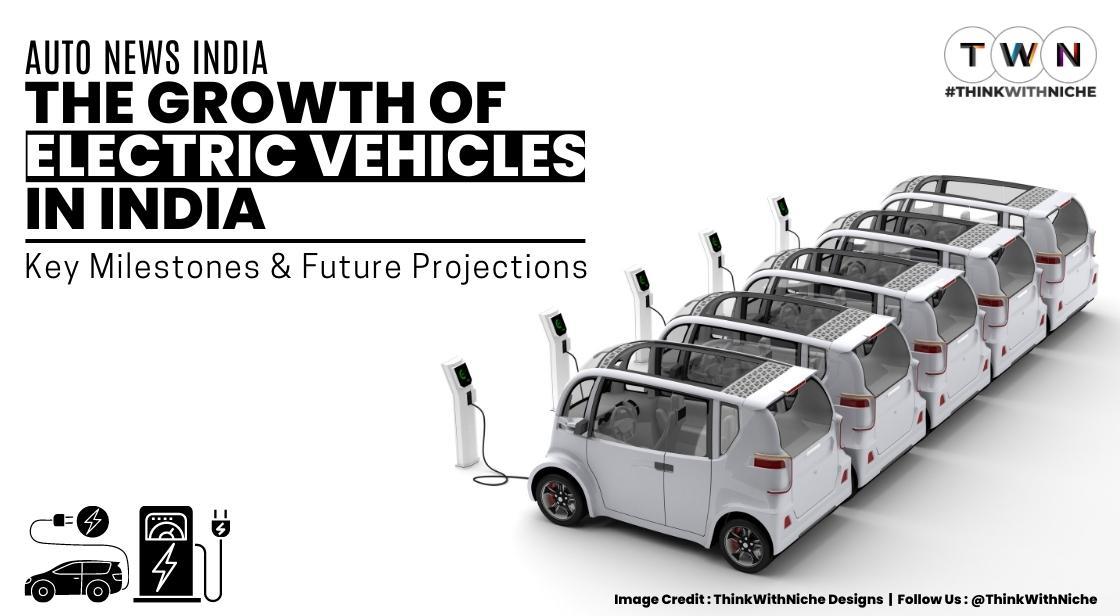The Growth of Electric Vehicles in India-Key Milestones and Future Projections

News Synopsis
Discover the major milestones in the growth of electric vehicle (EV) sales in India over the past two years, along with projections for the EV marketplace in 2047. Explore the role of auto manufacturers and government policies in promoting sustainable transportation, as well as concerns around battery manufacturing, charging infrastructure, and R&D.
The Exponential Growth of EV Sales in India
A joint report by KPMG and the Confederation of Indian Industry (CII) predicts exponential growth in electric vehicle (EV) sales in India for the rest of the decade, with two- and three-wheelers likely to dominate the market.
The report cites the launch of new EV models, the development of infrastructure, and government incentives as key drivers of the trend.
The Indian government has set ambitious targets for EV sales penetration, with a goal of achieving 30% EV sales for cars, 70% for commercial vehicles, 40% for buses, and 80% for two- and three-wheelers by 2030.
Major Milestones in the Growth of EV Sales in India
Over the past two years, several milestones have been achieved in the growth of EV sales in India. In 2021, Ola Electric launched the Ola S1 and S1 Pro electric scooters, which were met with high demand from consumers.
Tata Motors launched its Nexon EV and Tigor EV models in the same year, and Mahindra Electric launched its eKUV100 and eXUV300 models.
In 2022, the Indian government announced a new policy that would allow EVs to be sold without a battery, making them more affordable for consumers. In the same year, Hero Electric launched its AE-47 electric motorcycle, and Bajaj Auto launched its Chetak electric scooter.
Auto Manufacturers Driving the EV Trend
Several auto manufacturers have been driving the trend towards EVs in India.
Tata Motors has been a leader in the space, with the launch of its Nexon EV and Tigor EV models.
Mahindra Electric has also been a major player, with its eKUV100 and eXUV300 models. Ola Electric has been making waves in the electric scooter market, with the launch of its Ola S1 and S1 Pro models. Other notable players include Hero Electric, Bajaj Auto, and TVS Motors.
Concerns and Projections for the EV Marketplace
While the growth of EV sales in India is promising, there are several concerns that need to be addressed in order to ensure a sustainable motor ecosystem.
One concern is around technology innovation, particularly in the area of battery manufacturing.
The report highlights the need for next-generation technologies, such as advanced chemistry cells, that use alternative raw materials that are abundant in nature, cost-effective, and less impacted by market volatility.
Another concern is charging infrastructure. While the Indian government has taken steps to develop infrastructure, more needs to be done to ensure that EVs are accessible to all consumers.
Finally, R&D in the area of non-fossil fuel-driven sustainable motor ecosystems is crucial for long-term success.
Looking ahead, the projections for the EV marketplace in India are promising.
By 2047, the market is expected to grow to 22 million units, with the share of EVs reaching 80%.
This growth will be driven by a combination of factors, including government policies, technological innovation, and consumer demand.
The Role of Government Policies in EV Growth
One of the key drivers of the growth of EVs in India has been government policies aimed at promoting the adoption of sustainable transportation.
The Faster Adoption and Manufacturing of Hybrid and Electric Vehicles (FAME) Scheme, launched in 2015, has been instrumental in providing incentives to manufacturers and buyers of EVs.
The scheme was extended in 2019 with a budget of INR 10,000 crore ($1.34 billion) over three years, further boosting the growth of EVs.
In addition, the Indian government has also announced plans to establish a network of charging stations across the country, with a goal of having at least one charging station within a radius of 3 km in cities and every 25 km on highways.
This move is expected to increase the convenience of owning an EV and boost sales.
Major Auto Manufacturers Launching EVs
The global automotive industry has seen a surge in the number of EV launches in recent years, with major auto manufacturers entering the market with new EV models.
In India, Tata Motors has been a leading player in the EV market, launching the Nexon EV and Tigor EV models. Mahindra Electric has also been a major player, with its eKUV100 and eXUV300 models.
Ola Electric has been making waves in the electric scooter market, with the launch of its Ola S1 and S1 Pro models. Other notable players include Hero Electric, Bajaj Auto, and TVS Motors.
Globally, Tesla has been leading the EV market, with its Model S, Model 3, and Model X vehicles. Other major players include Volkswagen, which has launched the ID.4 and ID.3 models, and General Motors, which has launched the Chevy Bolt and Bolt EUV.
Addressing Concerns Around Battery Manufacturing
One of the key concerns around the growth of EVs in India is the availability of batteries and the sustainability of their production.
While lithium-ion batteries are currently the most popular choice for EVs, they are not sustainable in the long term due to the high demand for raw materials like cobalt and nickel.
To address this concern, next-generation batteries like solid-state batteries are being developed, which are expected to be more sustainable and efficient.
In addition, the Indian government is promoting the development of alternative materials for batteries, such as sodium-ion and zinc-air batteries, which are abundant in nature and less impacted by market volatility.
The government is also providing incentives for battery manufacturing, with the aim of making India a hub for battery production.
Projections for the EV Marketplace in India
The growth of EVs in India is expected to continue in the coming years, with the country projected to become a major market for EVs globally.
By 2030, EVs are expected to account for 30% of all new vehicle sales in India, up from less than 1% in 2020. By 2047, the market is expected to grow to 22 million units, with the share of EVs reaching 80%.
This growth will be driven by a combination of factors, including government policies, technological innovation, and consumer demand.
The Indian government's target of achieving 30% EV sales penetration for cars, 70% for commercial vehicles, 40% for buses, and 80% for two- and three-wheelers by 2030 is expected to play a major role in boosting the growth of the EV market in India.
ThinkWithNiche Final Take on the Auto News: Electric Vehicle (EV) Sales in India: Milestones, Projections, and Concerns
The growth of electric vehicles (EVs) in India has seen major milestones over the past two years. With the launch of new EV models, the development of infrastructure, and government incentives, adoption levels are expected to increase in the coming years.
The Indian government has set ambitious targets for EV sales penetration, and major auto manufacturers have been driving the trend toward EVs in India. However, concerns around technology innovation, battery manufacturing, charging infrastructure, and R&D in sustainable motor ecosystems must be addressed to ensure long-term success.
New Source: A joint report by #KPMG and Confederation of Indian Industry #CII for Government of India #MyGovIndia
Looking ahead, the projections for the EV marketplace in India are promising. By 2030, EVs are expected to account for a significant portion of new vehicle sales, with the market projected to grow to 22 million units by 2047.
This growth will be driven by a combination of factors, including government policies, technological innovation, and consumer demand.
To achieve these targets, collaboration between the government, auto manufacturers, and other stakeholders will be crucial.
Efforts to promote sustainable transportation must be continued, with a focus on developing sustainable battery technology, expanding charging infrastructure, and promoting R&D in non-fossil fuel-driven sustainable motor ecosystems.









